

... Laura Nikolich
By Scott Stilphen

The field of video game design is still largely considered the territory of men, as are those who play them. Although this certainly held true back in the 80s, I’ve always found it rather interesting that more women weren’t involved on both sides of the screen. The few women in the industry back then were not only adept and skilled programmers and designers, they were often very successful (Carla Meninsky, Suki Lee, Carol Shaw, Donna Bailey, Susan McBride, and Marilyn Churchill to name a few). And so it is with great pleasure and admiration that I had a chance to interview one such trailblazer – Laura Nikolich. One of her games, Spider-Man for the VCS, was recently named as one of EGM’s top 200 games of all time! Best of all, in the world of game design, the Nikolich family name doesn’t stop with her. Read on…
DP: What’s your educational background?
Laura Nikolich: I have a Bachelors of Engineering Technology from The University of South Florida. Computer Science at that time was still associated with the EE department and they really didn’t know what to call the degree since it wasn’t a true EE degree. A few years after I graduated, they changed it to a BSCS degree. I also have an MBA from the Florida Atlantic University.
DP: Did you work for anyone prior to going to Parker Brothers (after school)?
Laura Nikolich: My first job was with Systems Engineering Labs in Ft. Lauderdale, FL, where I worked on nuclear power plant monitoring systems, I then moved across the street to Motorola and worked on their telephone paging system. Pagers were the precursor to the cell phone. Both jobs required real-time assembler programming, which is where I developed the skills necessary for game design in the emerging video game industry. It was serious work, and you had a lot of higher-level engineers who were designing the actual paging systems themselves. They were these huge cabinets about the size of refrigerators, and you were working to their specifications to make sure that the pagers would beep each other.
When I received my MBA, I moved to suburban Boston to take a position as a group leader at financial software house McCormack & Dodge – how boring! I didn’t last a year. I naively thought I wanted to climb the corporate ladder. I quickly learned I had neither the killer instinct nor stomach for the politics involved in such a venture. I also desperately missed the technical challenges of my engineering background.
DP: What inspired you to go into game design? How did you come to work for Parker Brothers?
Laura Nikolich: It was serendipity. I had moved to the Boston area about a year before going to McCormack & Dodge. It didn’t take me long to realize I’d made a mistake and was very unhappy with my current career path. Part of my job was to meet with clients in order to help design custom software packages for them. I was at a local hotel to meet some clients and was a little early, so I was walking around the hotel. I stumbled across a job fair being held by Parker Brothers and wandered in. I knew of PB - who hasn’t played Monopoly or Clue? I also knew they were based on the North Shore but that was about it. It was the job fair where I really became aware of them. At first they treated me like, “What are you doing here?” because here I am, all dressed up in my business attire! They were being polite, but thought I was in the wrong place. I met Jim McGinnis, and once I started telling him what I did at Motorola, the rest is history. There weren’t a lot of people at that time with assembler-level programming, especially real-time programming. I went in for an interview, and they basically offered me a job on the spot. Extraordinarily good luck, or maybe it was fate.
I started in the fall of 1981. I was the 5th programmer hired; the 4th for the Atari project. Mark Lesser was concentrating on 8-bit hand-held games and wasn’t yet part of the project. I was laid off in the spring of 1984 along with everyone else. I was there 3 years and never regretted it.
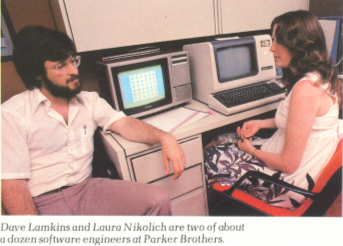 DP:
How was it working
for them?
DP:
How was it working
for them?
Laura Nikolich: It was the best job I ever had! No question. The people were fantastic to work with. It was a very open, supportive, and creative environment. We had a free exchange of ideas and helped each other with our gaming challenges. We were all good friends working together. The chemistry was wonderful and the management very supportive and accommodating. After we were all laid off, Rex Bradford had a party where he passed out buttons that said, “Another sad case of PBSS “ (Parker Brothers Spoiled Syndrome) and he was right. No other job ever measured up to that great experience. I still have my button.
Of course toward the end, things got a little dicey. The department had grown quickly and the closeness was fading. It all started to fall apart when the ‘gang of five’ left in the winter of 1982-83. We were never the same again. Our heart was gone. The industry was starting to shake out and Nintendo was entering the market. Atari collapsed, followed by the rest of the industry. In the end it was sad to go but also a relief. It was a magical time but nothing lasts forever. I’m just glad I was a part of it.
(Picture from an article from August/Sept 82 issue of Family magazine)
DP: What was the development process like?
Laura Nikolich: It was a group effort. We would brain storm game ideas and discuss the best approaches to implementing the ideas to minimize the platform’s limitations. We would review each other’s work and make suggestions for improving the games. We would also play each other’s prototypes to find bugs and to try to improve game play. The system worked because there were no egos involved. We were all just trying to create quality games.
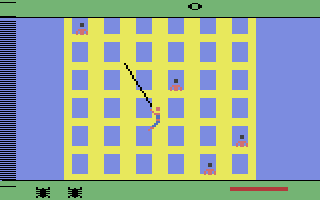
DP: At first glance, Spider-Man seems to be directly influenced by Nihon Bussan Crazy Climber arcade game (and ultimately far superior to Atari’s own licensed VCS version). How did the design for Spider-Man come about?
Laura Nikolich: The design was a result of the technical limitations of the system. To have a smooth web swing with varying lengths of web, Spider-Man had to stay in the center of the screen, so I wouldn’t have to worry about his location at the same time I was calculating the web length and place in the swing arc. Also, a vertical scroll was much smoother than a horizontal one as we could scroll vertically line-by-line whereas horizontally the scroll had to be in 4 or 8-bit increments (I can’t recall the exact number). The biggest thing was that marketing always wanted to scroll horizontally, instead of vertically, and that would have been hard to do. Rex’s Empire Strikes Back game had it, but you could see the scrolling wasn’t smooth. The only way to avoid a jerky horizontal scroll would require too much space to generate or store the landscape. Spider-Man was a 4k game and with 128 bytes of RAM - not a lot of room.
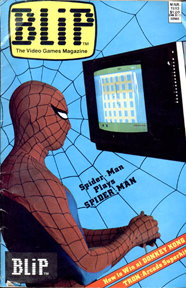 Spider-Man does resemble Crazy Climber but if we had
scrolled horizontally it would have been compared to Activision’s Pitfall
- damned either way. Crazy Climber was an arcade game though so it had a lot
more resources to work with. I remember reading some of the reviews, and a few
were pretty mean-spirited – basically deriding it as a take-off on Crazy
Climber. Given the technical limitations, Spider-Man was well done.
Spider-Man does resemble Crazy Climber but if we had
scrolled horizontally it would have been compared to Activision’s Pitfall
- damned either way. Crazy Climber was an arcade game though so it had a lot
more resources to work with. I remember reading some of the reviews, and a few
were pretty mean-spirited – basically deriding it as a take-off on Crazy
Climber. Given the technical limitations, Spider-Man was well done.
DP: Did marketing have any say on what villain to use?
Laura Nikolich: We decided on the Green Goblin since that was the main villain at the time, and also it was the easiest to do because he could fly. And the bandits in the windows were easy to do because you had 2 sprites so we could have one for the bandits and one for Spider-Man and have both on the same line w/o worrying about your sprite placement.
DP: (from David Lamkins) “The big technical challenge in that one (Spider-Man) was drawing the web without using a lot of resources. I remember that when Jim described the algorithm, I immediately recognized it (from my hardware background) as a digital differential analyzer (DDA) even though I don't think we were calling it that.”
Laura Nikolich: We did call it a DDA algorithm.
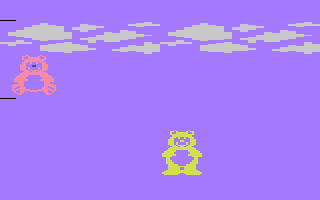
DP: Did you also do some work on a Care Bears game, or was that Dawn Stockbridge?
Laura Nikolich: I designed and wrote Care Bears. Care Bears was a technically interesting game. I designed a way to reuse a sprite as the line was being drawn. As the Care Bear was falling (scrolling) down from the clouds, I would have half of the graphics but when he hit a specific spot I would flip it. This enabled me to create much more detailed tummy graphics for the bears. I thought that part was wicked-cool, but marketing was like *yawn*. The game was complete and ready for Beta testing when it was cancelled. Marketing didn’t feel the market for younger children’s games was strong enough to go forward with Care Bears. I didn’t agree and still don’t.
DP: Was this another case of PB having the license for something and needed a game designed around it?
Laura Nikolich: PB was also writing children’s books for Care Bears. Care Bears was basically a manufactured thing, like Strawberry Shortcake was, and they were just trying to hit the young kids market to get kids to buy cereal or bears or to watch TV shows. It wasn’t like Marvel Comics where it had a history. I remember being a little kid and watching my cousins reading comics, so there was a background there that made them more “real”, whereas Care Bears was the equivalent of a boy band! Strawberry Shortcake was relatively successful and since PB didn’t have a lot of product in that market so they decided to do a Care Bears game for little kids, but then they decided that it was too simplistic. The game involved little bears that would scroll down and the player had to jump up and grab the tummy graphic. Once you had all the graphics you had to build them back up in a certain way in a certain amount of time. It was enough that it wouldn’t frustrate a 4 or 5-year-old, but this is who they were marketing it to! I mean, all the Care Bears stuff was for the under 8-year-old age group. I don’t know what they wanted…
DP: Did Marvel Comics have any input to the design of Spider-Man? Did American Greetings with the Care Bears?
Laura Nikolich: I never worked with Marvel Comics or American Greetings (http://www.care-bears.com/CareBears/html/history/index.html) for either of my games. If they had any input it was through marketing. We were free to design what we wanted but I guess if it didn't meet the licensing agreement we would have heard about it.
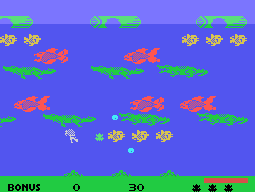 DP:
According to Larry
Gelberg, you both were part of the Frogger II “team”, and that you were working
on the Colecovision version. There was also a graphic artist (by the name of
Gary …. Do you recall his last name?)
DP:
According to Larry
Gelberg, you both were part of the Frogger II “team”, and that you were working
on the Colecovision version. There was also a graphic artist (by the name of
Gary …. Do you recall his last name?)
Laura Nikolich: There was a graphic artist but I don’t recall his name.
DP: How was the development for Frogger II on the Colecovision better/worse than Spider-Man?
Laura Nikolich: The development of Spider-Man was more enjoyable because we had full creative control. There were no other Spider-Man games on the market at the time and the game was entirely my baby, with creative input from the others of course. We were free to create what we wanted. With Frogger II, it was a sequel with rigidly defined parameters. We were limited in our creativity and design. Also, it was developed in the waning days of the industry; it was imploding, and we knew it. We had pretty much stopped original game development and began just porting arcade games to home platforms. Although Frogger II wasn’t an arcade game, we had the ability to design what we were going to be jumping over, but that was about it. Although there were a few different scenes, they were all basically the same type of scrolling across the screen and the same gameplay. There was nothing really creative about it other than the artwork.
DP: What were your feelings about porting over arcade games compared with doing original designs?
Laura Nikolich: We (the original programming group) thought doing ports was very uncreative; you’re just programming someone else’s work and putting it on a different system, instead of doing the original game design and story. With games like Spider-Man or Star Wars you could design the game any way you wanted to – how it would play, what it would look like, etc. The thing I liked most about it was the creativity. Programming itself is boring, even if you are making pretty pictures. That’s the reason I didn’t like working at straight-up programming.
DP: Were the VCS and the Colecovision the only systems you worked with?
Laura Nikolich: Yes, I explored the Intellivision a little but never worked on it.
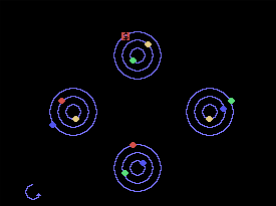
DP: Before Frogger II, were there any other games or projects that you worked on that ultimately never got released, or even finished?
Laura Nikolich: I was working on a game for the Colecovision after Care Bears was killed, called Orbit. It was a puzzle came that consisted of different colored balls spinning in a classic atom like structure. Each ring of the atom was a different color and the idea was to get the balls on the ring of the same color. Of course the intersections of the rings posed an opportunity for the balls to jump rings, or to be placed on the right ring. It was in the first stages of development - storyboards and rough prototype demos - when I was pulled to work on Frogger II for the Colecovision.
DP: Regarding your games, were there any features you would have liked to added , or any known bugs or glitches that gave you trouble (or never got resolved)?
Laura Nikolich: There is one bug in Spider-Man I never could find. In certain instances, the criminals in the windows will be one line above the window, making them look a little disembodied. I put a logic analyzer on it, Dave Lamkins and a few others tried to help me find it but we never did. It wasn’t an issue with marketing or anything – we just wanted it perfect. In Beta testing it was never an issue so it shipped with this mild glitch. It drove me crazy though.
One interesting bug did surface in Beta testing. I had done the hit-detection on the buildings, but it never occurred to me that Spider-Man could go off it! As we watched the play-testing it, I saw one kid go off the side of the building and climb up the sky – avoiding everything! Here were all these programmers who routinely play-tested each other’s games and none of them caught that. I fixed that one real quick!
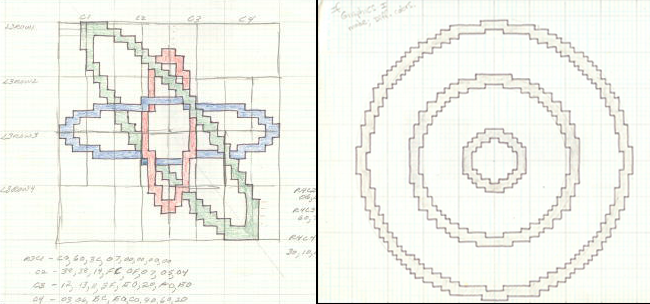
Some of Laura’s bit pattern notes for Orbit
DP: Do you remember what early or tentative titles your other games had (if any)? Do you recall any other titles that other programmers were working on that were never released, or finished?
Laura Nikolich: I’m sure there were other games not released but I can’t recall any specific games. It’s been a long time.
DP: Occasionally, programmers would put little “Easter eggs” in some of their games that would reveal their name, or a message? Are there Easter eggs in any of your titles? Do you recall any fellow co-workers that did?
Laura Nikolich: I didn’t have the space to hide anything and I don’t recall any of the others doing it either.
DP: What were some of your experiences working for PB?
Laura Nikolich: In the early days management would give us rolls of quarters and send us to the arcade for the afternoon to stimulate game ideas! It was a tough job, but we managed. I also remember sending our group to see the movie, Tron. I don’t remember if Parker Brothers was pursuing the license for the game or if we were just looking for ideas, but it was fun either way. After a game got released, they would send us to a Chinese restaurant or wherever we wanted to go for a celebration dinner. I remember a funny story with Larry at a Chinese restaurant in Lexington, but I’ll let him tell it J
Aside from typical staff meetings, sometimes someone would call a meeting because they needed help with a game, so most people would go if they had time to spare from their projects. There was one afternoon when we getting a little silly right before a group meeting in the lab area. We were sitting in wheeled office chairs on a linoleum floor, and a spontaneous game of ‘bumper chairs’ broke out. It was a lot of fun but others on the floor must have thought we were crazy! We eventually settled down and had the meeting. They didn’t mind if you spent an afternoon goofing off because a lot of times, idea for games and things would come out of that. I don’t remember ever going off-site, for an extended period of time, for a brainstorming session, other than out to lunch or the arcade; sessions were mostly held in the offices, or outside if the weather was nice (I remember an impromptu snowball fight one winter!). The PB campus in Beverly was set back in the woods, so it was a good environment. But you can’t have that many young and creative people together, who are given that much support and free reign, and not expect things to happen!
By the time I was working on Frogger II, the place was so big that we had separate groups of programmers. I was part of the original group. After Care Bears was cancelled, I went onto work on Orbit, and as I was doing the main little prototypes for Orbit when PB said, “That’s it. No more original games. We’re just going to do licensing games.” So we could see things starting to go down, but they also had us in this bonus program where if you left the company, you left all that money on the table. For every game that was released, we got a chunk of money, like $25k; $1k went to the designer/programmer and the rest was divided up among our group of original programmers and put into our own individual accounts. So every time a game was released, there was money put into our accounts. PB wasn’t doing that for anyone else. The only stipulation was you had to stay with the company a certain amount of time in order to get the money, because a lot of times other game companies were trying to raid other people’s programmers. When the original “gang of five” left, they left all that money there. I got calls from Mattel and from some place in Chicago (possibly Midway). They would get a phone listing and start calling everyone. The bonus program was supposed to be kept secret, but you can’t have a company that big and not have something like that leak out. So for a lot of us when I finally got laid off it was a relief - people were losing their jobs and there was a lot of back-biting. I’m sure there was some jealousy from the “porters” – people doing arcade ports – towards the original programmers over the bonus program. I was laid off just as Frogger II was being readied for release. It was sad to go, but at the same time I got the bonus check and was able to buy my house, so it worked out. I couldn’t really say anything bad about PB because they really did try to take care of you after you were laid off. They had a really good severance package, and the opened up offices where we could go and get help with finding another job - they even helped distribute our resumes.
DP: Can you describe your career, from your time at PB and now? Since PB, have you stayed within the field of game design? If not, why did you leave the video game industry? And would you ever consider getting back into it?
Laura Nikolich: After PB, I worked for GCI Designs working on a graphic generator . They liked the fact that I had done so much graphics stuff, but the work I did there wasn’t anything you could really “see”; you were doing the software so that someone else could draw with it. The people there were nice, but I was back to doing boring programming. I was expecting my 2nd child at the time, so after 6 months I left and became a full-time mom.
After GCI, I consulted for Wang Labs 3 days a week, porting Windows to their Wang PC during my 3rd pregnancy. Both versions were identical except the addressing was completely backwards, so all they had to do was take everything and flip the addressing of it, but again it was porting software. Since then I’ve been a stay-at-home mom.
Now that my 4 kids are almost grown, I’m getting laid off from that job too! I would consider reentering the industry, but I feel it has grown very competitive and cut throat - probably not my idea of a good time and I definitely don’t need the stress. I would most likely look into doing user-friendly interfaces for consumer products or freelance web design.
DP: What are your thoughts on how the industry has evolved?
Laura Nikolich: It has turned into a multi-faceted industry. Two of my sons are interested in pursuing gaming careers. My oldest son, Evan, wants to design and program gaming software (he recently worked on EA’s Madden ’05). My 2nd son, Kyle, is pursuing the artistic elements and is very interested in Pixar-type animation. The game industry is now big business with all that entails. When we were the pioneers, there were few rules and little pressure and competition between colleagues. That is what made Parker Brothers such a unique experience. How many job experiences can people truly say they worked with friends and didn’t have to watch their backs at all times?
I remember people who I had worked with prior to PB telling me, “What are you doing, making games? Aren’t you afraid of ruining your career? Don’t you want to do serious programming?”. But the younger people in my family back then ‘got it’. Evan has run into the same thing. He does campus tours for freshman, and parents will ask him what he does, and when he tells him about his internship work with video games, some will go, “What are you going to do when you get a real job?” or “You’re a Computer Engineer – what would you want to do that for?”.
DP: So there’s still this stereotypical attitude towards game programming…
Laura Nikolich: Some people just can’t see the market that has grown up around these games. It’s a billion-dollar industry. And it’s not trivial programming. Even back then when we were doing our games it wasn’t trivial by any stretch of the imagination. You had to write code so tight that you had to count cycles going across the screen, right down to the hardware. There weren’t any levels of software above it. You couldn’t do any of today’s top-down structured programming. That was one of the hardest things to get Larry Gelberg to stop doing, because he would waste so much time trying to structure his program so people could read it easily, but when you’re trying to write a game in 4K and get as much in there as you possibly can, you have to shave all that stuff off.
DP: I can’t imagine it’s as satisfying to design a game now as it was back then…
Laura Nikolich: The projects now are so huge and there are so many people involved with it that nobody really ‘owns’ it. Back then you had complete creative control, and you could point to a game and say, “I did that!”. No one ever told me how to do Spider-Man. We had a few conversations with the marketing people but we would just explain the limitations of the system, and then we’d get our way. It’s not like we were trying to go off-license, because everything was still true to the character. They gave us a bunch of comic books, which I read, but I knew about Spider-Man; I’d seen the cheesy afternoon shows! So it really wasn’t too hard to come up with a game. We didn’t have any problems with marketing people once they accepted the fact that we were going to vertically scroll, and from there I just went off into basic ‘hibernation’ to program it. I started it in April (?), and PB wanted to take it to the summer CES show in June (?), but at that time I only had the buildings up. It was very rudimentary (not playable), and PB kept pushing me to make something playable out of it. So I finally got the swinging Spider-Man in but marketing felt that wasn’t good enough for the show, so instead they just put up a little poster! I did get a lot done on the game, but I was going to work in a different way. Overall it was a lot of fun to do.
The sad part about the majority of those games when you’re playing them is that they just get faster and faster, until you can’t do it any more. People nowadays will say things about that, that they didn’t have an ending., but most of those games are only 4K! The stack that we were working with only had 128 bytes for your tables, routines… everything! So that’s why the games are so simplistic, and why the graphics are so “chunky”. They had to be because that was the limitations of the system. My younger son once commented about them, saying, “I feel sorry for the kids back then who had to play these games!”. We thought they were great.
DP: Well, when you don’t have anything to reference them against…
Laura Nikolich: Exactly! I told him, “What do you think your kids will say about your games?”. But games are so much more complex now. I read an article that said today’s games are good for kids because that’s the way society is evolving.; they’re picking up skills that they’re going to need, such as the way they need to “multiplex”, and these games actually help them to process this stuff and become more familiar with it. When I was a kid, everything was more linear! My daughter can be listening to music, doing homework, and IM’ing with 4 other people - all at the same time - and still get A’s. They all do it.
DP: Your "prototype parties" are the stuff of legend, primarily because of who was there and the prototypes that were shown! How many of these PB get-togethers did you host? Are there any photos from them?
Laura Nikolich: There were at least 3, not to mention a few Halloween costume parties. I remember Ray Miller bringing a pumpkin with Pac-Man carved on it! I have to dig out my pictures some time. Ray also attended the parties with Q-bert and maybe the Return of the Jedi game.
DP: Have you stayed in touch with any of your old fellow ex-PB co-workers?
Laura Nikolich: I’m in touch with Rex Bradford and could contact many others. Rex has since really got into the Kennedy assassination plot, and I actually saw him on TV last Thanksgiving being interviewed by some Congressional Commission in Washington! In fact this interview has given me a desire to host another party. Only this time it would have to be a Video Game Geezers Reunion! Rex and his wife used to have reunions for some time on almost a yearly basis, usually in late summer or early fall, but they stopped when they had children.
DP: What are some of your all-time favorite video games (besides those that you worked on
Laura Nikolich: My favorite games from the era were Centipede and Pac-Man in the arcade, and Stampede and Kaboom for home systems on the Atari 2600. One afternoon when we were being silly in the lab we “discussed” changing the graphics in Kaboom and renaming it “Save Your Sister” (use your imagination) - we always did have a good time!
DP: Thanks for your time, Laura
For a copy of the Parker Brothers article from the August/Sept 1982 issue of Family magazine, click HERE.
For a copy of the Spider-Man article from the March 1983 issue of Blip magazine, click HERE.
For a copy of the complete archive package for Orbit (including bit patterns, source code, manual, and ROM), click HERE.
| GAMEOLOGY |
| GAME | SYSTEM | COMPANY | STATUS |
| Spider-Man | Atari VCS/2600 | Parker Brothers | released |
| Care Bears | Atari VCS/2600 | Parker Brothers | not completed |
| Frogger II: Threeedeep! | Colecovision | Parker Brothers | released |
| Orbit | Colecovision | Parker Brothers | not completed |